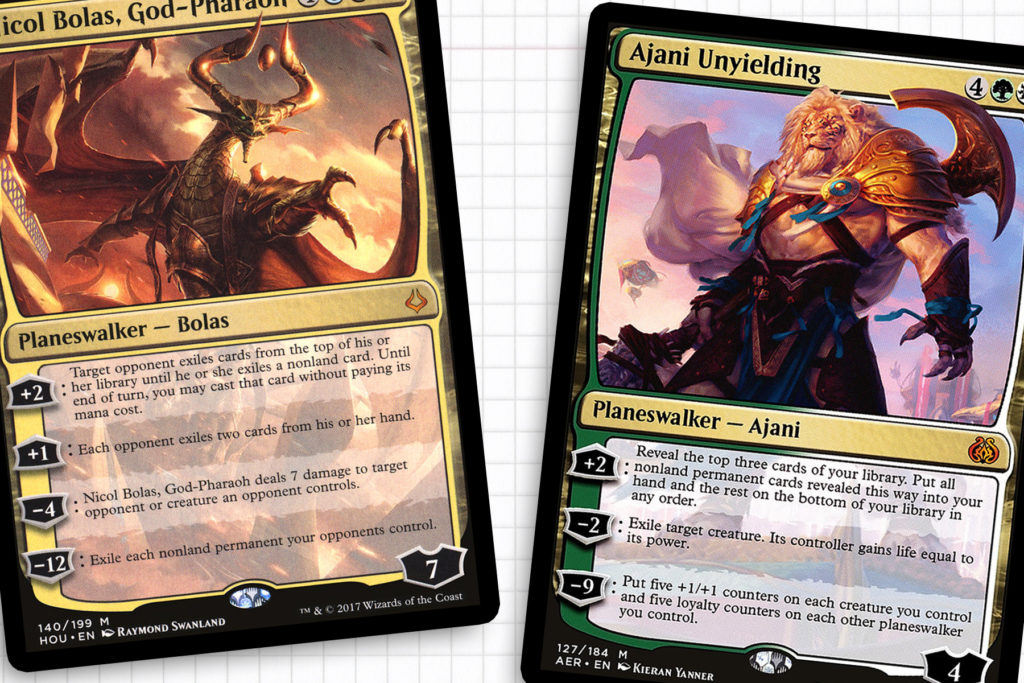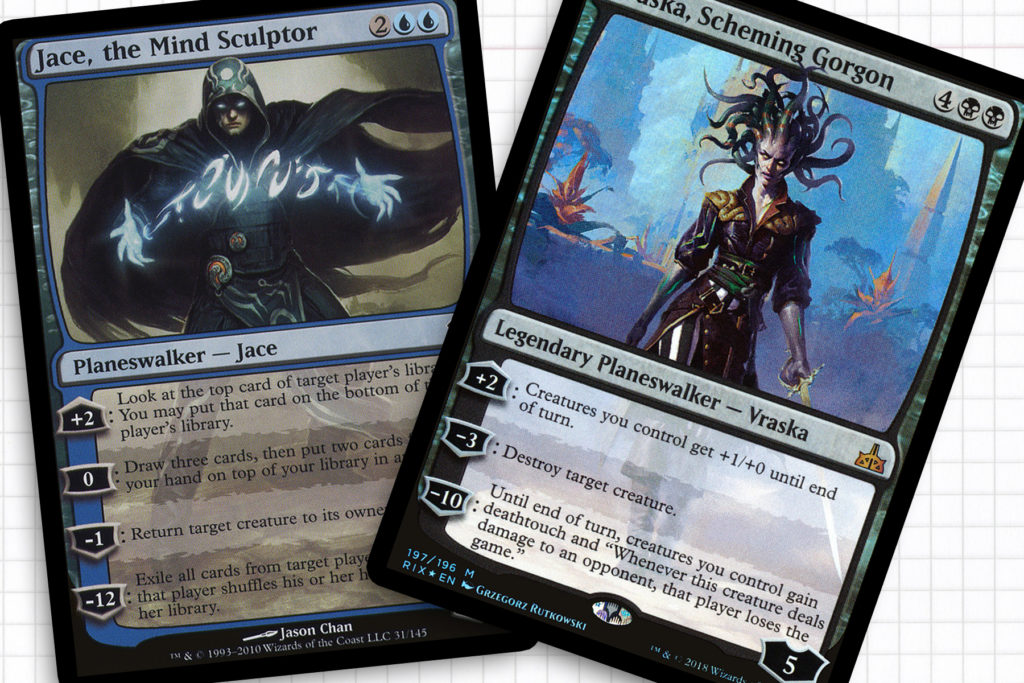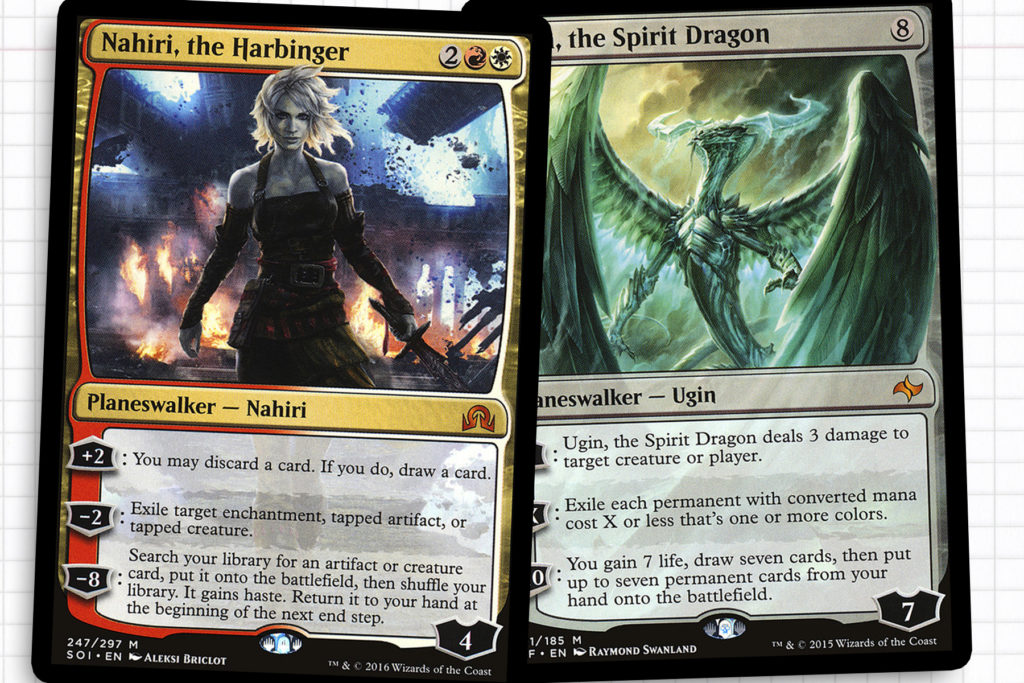A few weeks back on Twitter user Turn One Thoughtseize posed the question of a Modern where planeswalkers were banned and a Commander format where planeswalkers were legal commanders—you know, outside of the 10 who are. This got me thinking about the topic of a Commander format where planeswalkers were officially or house-ruled into being legal generals, as it is commonly a point of discussion among players. I rarely talk much about planeswalkers in my deck skeletons, because so often they lose a lot of their power level in a multiplayer setting. My biggest concern wasn’t if it would be too warping, but if this change would be too underwhelming.
So today, instead of trying to breakdown a deck list in this imaginary format, I will be outlining where the current choice of planeswalkers might push the established format. I will be looking at three pieces of criteria that I believe would be essential to making any choices work; the ability to gain more than one loyalty a turn, the ability to protect themselves, and the ability to achieve an ultimate quickly. While this is not the most scientific of methods, I hope that it might distill a handful of options amongst the color pie, if doing nothing more than giving insight as to how I evaluate a planeswalker.

Showing Loyalty
Planeswalkers exist in this space where they avoid spells like Go for the Throat and Terminate, but can be hit by Hero’s Downfall or combat damage. Because of this my first piece of criteria I believe would put a planeswalker into the running to be an effective general is the ability to gain more than one loyalty counter on a plus ability. While not essential—a case could be made that a card like Liliana Vess is handy mostly for the tutor ability—I believe that in a multiplayer format being able to stick around for longer is going to be dependent on accumulating loyalty faster. I took to Scryfall to do a quick survey for the cards matching my need for sustaintable loyalty growth:
Ajani Unyielding, Ajani, Valiant Protector, Angrath, Minotaur Pirate, Ashiok, Nightmare Weaver, Chandra, Pyrogenius, Elspeth Tirel, Gideon, Champion of Justice, Gideon Jura, Gideon, Martial Paragon, Huatli, Dinosaur Knight, Huatli, Radiant Champion, Huatli, Warrior Poet, Jace Beleren, Jace, the Mind Sculptor, Karn Liberated, Liliana, Death Wielder, Nahiri, the Harbinger, Nicol Bolas, Planeswalker, Nicol Bolas, God-Pharaoh, Nicol Bolas, the Deceiver, Nissa, Genesis Mage, Nissa, Nature’s Artisan, Nissa, Steward of Elements, Sorin Markov, Ugin, the Spirit Dragon, Venser the Sojourner, Vraska, Relic Seeker, Vraska, Scheming Gorgon
Looking at the 28 cards that meet this criteria, I was a little blown away by the sheer number of planeswalkers that made the cut. When I think about huge leaps in loyalty, my mental list normally starts and ends with Karn, Nicol Bolas and Ugin; all massive planeswalkers that hit the table hard. It should be noted that beyond my perceived assumption, being three colors does not inherently mean you qualify here either, as Sarkhan Unbroken didn’t make the cut. Overall, these findings were rather surprising, especially since all colors were represented.
The results are a little skewed by the high saturation of Planeswalker Deck cards, but I think they are worth highlighting. They get far less attention, but are worth keeping in mind for their more niche designs. This is the first time I’ve really analyzed Liliana, Death Wielder, and now I want to pair her with The Scorpion God or Kulrath Knight. I also chose to include Gideon, Champion of Justice and Huatli, Radiant Champion because it is fair to assume that both will be able to gain more than one—if not substantially higher—points of loyalty than any other planeswalker available. I would put more stock in Huatli, as the loyalty accrued is likely to be maintained since it’s linked to your own populated battlefield.

Defend Yourself
Another quality that makes for a viable planeswalker as a general isn’t any different than in other constructed Magic formats: the ability to protect oneself. Considering that planeswalkers can generate varying levels of value each turn, they become obvious targets. But, if their method of generating value also includes protecting themselves with a glorified Murder, Unsummon, or Raise the Alarm, all the better. The archetypical example of this is Garruk Wildspeaker, who created a 3/3 Beast token as his minus ability, but I think one of the best might be Elspeth, Sun’s Champion who created three 1/1 soldiers as a plus ability.
As a sign that Wizards understands how players evaluate planeswalkers from a competitive standpoint, there is a generous amount of planeswalkers who protect themselves—63 by my count. While I would love to go over some of the merits of cards falling outside of the previous criteria, going purely off our established list the following cards make the cut:
Ajani Unyielding, Angrath, Minotaur Pirate, Elspeth Tirel, Huatli, Warrior Poet, Jace, the Mind Sculptor, Karn Liberated, Nahiri, the Harbinger, Nicol Bolas, Planeswalker, Nicol Bolas, God-Pharaoh, Nicol Bolas, the Deceiver, Nissa, Genesis Mage, Nissa, Steward of Elements, Sorin Markov, Ugin, the Spirit Dragon, Vraska, Relic Seeker, Vraska, Scheming Gorgon
After cutting the list down by a third and without diving into the specifics of these cards, it is impressive that four of the Planeswalker Deck ‘walkers still make the cut here. Disregarding converted mana cost as a metric—while being niche, they were designed with less competitive play in mind—it makes sense they might be built to find a home in a casual format like Commander.
Being a little subjective, there’s a thin line between Ugin’s plus ability and Sorin’s where I was considering removing Sorin from contention. Two damage certainly can defend against a small creature, but three damage kills a lot more. Nicol Bolas, God-Pharaoh also stands out to me, as his design leads towards dealing with multiple opponents at once, an issue I will elaborate on later.
To note, among these planeswalkers, only Nissa, Genesis Mage and Vraska, Relic Seeker protect themselves with blockers while also gaining loyalty. In case my standards don’t align with yours; other notable options that protect themselves in this way, but didn’t make it through the last section’s criteria include Elspeth, Sun’s Champion, Daretti, Ingenious Iconoclast, and Nissa, Worldwaker.

Limit Breaking
It’s strange to me that planeswalkers often get judged so heavily by their ultimate ability, as time has shown that they are not something that normally gets used very often. In Commander I feel this is even more so, as you’re fighting off an extra player or two. I still think they are important to keep in mind though, so my last line to find a core group of planeswalkers that might be able to stand as generals is examining them for their ability to reach their ultimate in a minimal amount of time. My metric is reaching an ultimate with two or less activations of a plus ability. This way you can activate their ability the turn they come into play, activate it again next turn and be able to ultimate the second time you until tap with it. Or if, you’re sneaky, even faster with The Chain Veil. This is a short list:
Elspeth Tirel, Huatli, Warrior Poet, Karn Liberated, Nahiri, the Harbinger, Nicol Bolas, Planeswalker, Nissa, Steward of Elements, Sorin Markov, Ugin, the Spirit Dragon, Vraska, Relic Seeker
From this list Nicol Bolas, Planeswalker caught my attention the most. Looking at him, I had to wonder if his abilities were strong enough to make him a viable general, even with his high converted mana cost. I turned to resident Elder Dragon, HobbesQ, for his opinion on the planeswalker’s viability.
“The [converted mana cost] makes it very difficult to cast compared to most of the other [planeswalkers].” How quickly he can reach his ultimate is good, but only against one player, adding, “in some ways it lends itself to very linear Grixis control build.”
When I explained the criteria I used to reach my findings, he agreed that the logic was sound on paper, but that in his experience Bolas—as a part of the 99—draws a lot of hate. All of this is a very important factor to keep in mind, especially with how these decks might have to be built to accommodate these new generals.
Hobbes’ point on threat level reminds me of a game I played at Grand Prix Las Vegas in 2015, where I was able to ultimate Sorin, Solemn Visitor simply because no one knew what the ultimate was and how detrimental it would be to their game plan. This causes me to get subjective on the final judgment with the remaining list. From an unbiased position, all nine of these cards are viable on paper, but I believe that only Nahiri, the Harbinger, Nissa, Steward of Elements, and Vraska, Relic Seeker have the power set, ability to answer or create threats, and low enough profile to achieve their goals.
Nahiri draws you cards if she’s not being threatened, protects herself if she is, and tutors a creature or artifact out Sneak Attack-style. Nissa works uniquely with commander tax, filters the top of your library and either cheats in threats or build towards creating ten power in the air. And finally, Vraska creates blockers while gaining loyalty, destroys three different kinds of permanents, all building towards setting a player to 1 life.
My biggest takeaway from this thought experiment is that I don’t really feel like Commander would change enough to make changing the rule a net positive for the format. Wizards should absolutely design more planeswalkers with the text “X can be your commander,” but I don’t need any revisionist history. Admittedly the criteria I set to objectively judge our current lot of planeswalkers is harsh enough that only Freyalise, Llanowar’s Fury actually passes all three “trials” of the Commander 2014 planeswalkers that are already legal.
The usefulness of a planeswalker in the commander zone is going to ultimately come from how powerful they are when cast multiple times in game, which could put just about any planeswalker in the conversation. But I would rather have Sidisi, Undead Vizier at the helm over Liliana Vess in most games. I would love to hear other people’s thoughts, but I hope my analysis can provide some insight into how to judge planeswalkers in general as new ones get spoiled each set. I want to thank Turn One Thoughtseize for giving me the go-ahead to cover this topic without feeling like I was stepping on his toes. But until next time, thanks everyone.

